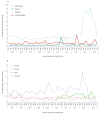Potential adjustment methodology for missing data and reporting delay in the HIV Surveillance System, European Union/European Economic Area, 2015
- PMID: 29897039
- PMCID: PMC6152165
- DOI: 10.2807/1560-7917.ES.2018.23.23.1700359
Potential adjustment methodology for missing data and reporting delay in the HIV Surveillance System, European Union/European Economic Area, 2015
Abstract
Accurate case-based surveillance data remain the key data source for estimating HIV burden and monitoring prevention efforts in Europe. We carried out a literature review and exploratory analysis of surveillance data regarding two crucial issues affecting European surveillance for HIV: missing data and reporting delay. Initial screening showed substantial variability of these data issues, both in time and across countries. In terms of missing data, the CD4+ cell count is the most problematic variable because of the high proportion of missing values. In 20 of 31 countries of the European Union/European Economic Area (EU/EEA), CD4+ counts are systematically missing for all or some years. One of the key challenges related to reporting delays is that countries undertake specific one-off actions in effort to capture previously unreported cases, and that these cases are subsequently reported with excessive delays. Slightly different underlying assumptions and effectively different models may be required for individual countries to adjust for missing data and reporting delays. However, using a similar methodology is recommended to foster harmonisation and to improve the accuracy and usability of HIV surveillance data at national and EU/EEA levels.
Keywords: Europe; HIV infection; missing values; multiple imputations; reporting delay; surveillance.
Conflict of interest statement
Figures




References
-
- European Centre for Disease Prevention and Control (ECDC). European Network for HIV/AIDS Surveillance. Stockholm: ECDC. [Accessed 29 May 2018]. Available from: https://ecdc.europa.eu/en/about-us/partnerships-and-networks/disease-and...
-
- European Centre for Disease Prevention and Control (ECDC). Long-term surveillance strategy 2014– 2020. Stockholm: ECDC; 2013. Available from: https://ecdc.europa.eu/sites/portal/files/media/en/publications/Publicat...
-
- Little RJA, Rubin DB. Statistical Analysis with Missing Data. 2nd ed. Hoboken, New Jersey: John Wiley & Sons; 2002. 381 p.
-
- Carpenter JR, Kenward MG. Missing data in randomised controlled trials - a practical guide. Birmingham: London School of Hygiene and Tropical Medicine (LSHTM) Research Online; 2007. Available from: http://researchonline.lshtm.ac.uk/4018500/
-
- Lawless JF. Adjustments for Reporting Delays and the Prediction of Occurred but Not Reported Events. Can J Stat. 1994;22(1):15-31. 10.2307/3315826.n1 - DOI
Publication types
MeSH terms
LinkOut - more resources
Full Text Sources
Other Literature Sources
Medical
Research Materials
